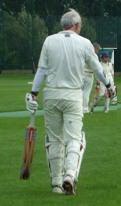 |
| Maurice Ravel |
They will feel désolé, affligé, inconsolé, désespéré, misérable, triste, affligeant, abandonné, désert, malheureux. All a bit French in fact. Is it this Frenchness which is a factor behind the lack of cricketing material in the works of Ravel?
Putting this apparent limitation behind him, Fantasy Bob found himself in the Usher Hall earlier this week enjoying Ravel's ravishing music played superbly by the Royal Concertgebouw Orchestra under five-star conductor Mariss Jansons. Test Match Quality.
 |
| Mariss Jansons |
So evocative is it that FB began to wonder whether Ravel have gained his inspiration from this piece by exposure to just such a cricket ground?
Ravel made several visits to Britain during his career. His first visit was a the end of April 1909, the same year that he began work on Daphnis and Chloe and may well have caught the opening matches of the season. Coincidence? FB doesn't think so. (Sadly FB notes that while Ravel visited Edinburgh several times he did so only during the winter months, so it is unlikely that he took his inspiration from a morning visit to Carlton's prestigious Grange Loan HQ.)
It is less easy to track the cricketing inspiration in his later works although some of his visits to Britain coincided with significant cricketing events which may well have stuck in his mind. In 1922 he was in England shortly after Warwickshire and Hampshire took part in one of the most remarkable of all County Championship matches. After making 223 Warwickshire dismissed Hampshire for only 15, Following on, Hampshire did better, but were still struggling when a 9th wicket partnership of 180 lifted them to 521. Warwickshire needed 314 to win but were bowled out for 158 to give Hampshire a remarkable win in one of the greatest comebacks in cricket - and the inspiration behind Ravel's blues influenced violin sonata finished the year after.
 |
| Iftikhar Ali Khan Pataudi - known to his pals as Nawab |
In July 1931 Ravel conducted at Covent Garden at the same time as the annual University match between Oxford and Cambridge was underway at Lords. Might he have spent the day there watching the Nawab of Pataudi stroke the Cambridge bowlers to all parts of the ground to make 238*? His subsequent work suggests as much.
For in 1931 Ravel completed his Piano Concerto, also part of the concert programme attended by FB. There seems little argument that the languid, elegant and beautiful second movement is a fitting tribute to this fine innings.
The Nawab was subsequently selected for the Ashes tour in what became the bodyline series. He scored a century in his first Test innings but struggled subsequently - both with his form, the bodyline tactic and, personally, with the skipper Jardine of whom he said, 'I am told he has his good points. In three months I have yet to see them.' Ravel did no meet Jardine, but his music suggests he may have had similar reservations about the tactic.
Pataudi subsequently skippered India on their tour of England in 1946. Tragically, Ravel could gather no further inspiration from the Nawab for he died in 1937, without adding to the cricket references in his work.

No comments:
Post a Comment